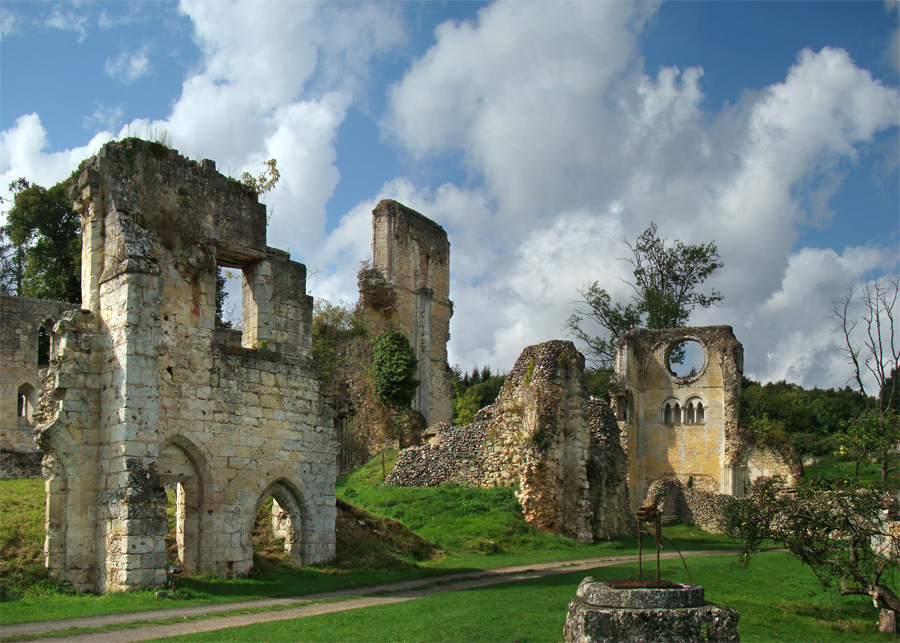Mortemer Abbey on:
[Wikipedia]
[Google]
[Amazon]
 Mortemer Abbey (french: L'Abbaye de Mortemer) is a former Cistercian
Mortemer Abbey (french: L'Abbaye de Mortemer) is a former Cistercian
Vidéo sur l'abbaye (1993)
(in French)
Site officiel de l'abbaye de Mortemer
(In French)
Further information on the abbey, its legend and ghosts, with images.
(Eng.) {{Authority control Cistercian monasteries in France Christian monasteries established in the 12th century Religious organizations established in the 1130s Religious buildings and structures completed in 1134 1790 disestablishments in France Buildings and structures in Eure Ruins in Normandy Tourist attractions in Eure Ruined abbeys and monasteries
 Mortemer Abbey (french: L'Abbaye de Mortemer) is a former Cistercian
Mortemer Abbey (french: L'Abbaye de Mortemer) is a former Cistercian monastery
A monastery is a building or complex of buildings comprising the domestic quarters and workplaces of monastics, monks or nuns, whether living in communities or alone ( hermits). A monastery generally includes a place reserved for prayer whi ...
in the Forest of Lyons between the present Lyons-la-Forêt and Lisors, some southeast of Rouen in the department of Eure. It is located on the territory of the commune
A commune is an alternative term for an intentional community. Commune or comună or comune or other derivations may also refer to:
Administrative-territorial entities
* Commune (administrative division), a municipality or township
** Communes of ...
of Lisors.
History
It was originally built in 1134 on land presented as a gift to the Cistercians by Henry I of England. The stagnant water of the drainage lake, dug out by the monks to dry up the marshy land around the quick-running Fouillebroc stream, was called the "dead pond" - in French "morte mare" - and gave the monastery its name. The monks constructed what was then one of the largest Cistercian monastery in the world. Over the centuries, the abbey fell into decline and disrepair. It was rebuilt in the 17th century, but the decline was irreversible and by 1790, when it was dissolved in the course of theFrench Revolution
The French Revolution ( ) was a period of radical political and societal change in France that began with the Estates General of 1789 and ended with the formation of the French Consulate in coup of 18 Brumaire, November 1799. Many of its ...
, only five monks remained.
Buildings
The 12th-century buildings were already more or less derelict by the time of theFrench Revolution
The French Revolution ( ) was a period of radical political and societal change in France that began with the Estates General of 1789 and ended with the formation of the French Consulate in coup of 18 Brumaire, November 1799. Many of its ...
, and subsequent use as a convenient source of cut stone for local construction reduced them to little more than a ruin. Apart from the cloisters, which are relatively intact, there remains only a shell.
The 17th-century buildings by contrast are well preserved and open to visitors, with guided tours available most of the year.
The abbey site also has a well-maintained 17th-century dovecote
A dovecote or dovecot , doocot ( Scots) or columbarium is a structure intended to house pigeons or doves. Dovecotes may be free-standing structures in a variety of shapes, or built into the end of a house or barn. They generally contain pige ...
, which was also used as a gaol house in the 18th and 19th centuries.
Legends
There are a number of legends and ghost stories relating to the abbey.Matilda of England
Empress Matilda ( 7 February 110210 September 1167), also known as the Empress Maude, was one of the claimants to the English throne during the civil war known as the Anarchy. The daughter of King Henry I of England, she moved to Germany as ...
was forced by her father Henry I Henry I may refer to:
876–1366
* Henry I the Fowler, King of Germany (876–936)
* Henry I, Duke of Bavaria (died 955)
* Henry I of Austria, Margrave of Austria (died 1018)
* Henry I of France (1008–1060)
* Henry I the Long, Margrave of the ...
to stay in a room in the abbey for 5 years. After her death in Rouen, she is said to have come back to haunt the place. Her ghost is known as ''The White Lady''. Visitors to the abbey have reported hearing strange noises and feeling a strange presence.
Four monks were murdered during the French Revolution
The French Revolution ( ) was a period of radical political and societal change in France that began with the Estates General of 1789 and ended with the formation of the French Consulate in coup of 18 Brumaire, November 1799. Many of its ...
and their ghosts are also said to haunt the abbey. If you meet a cat in the ruins, it is alleged to be a Goblin cat ( nrf, eul cat goublin), guarding the treasure of the abbey. There are a number of other legends, giving the abbey the nickname of as ''most haunted abbey in France''.
External links
Vidéo sur l'abbaye (1993)
(in French)
Site officiel de l'abbaye de Mortemer
(In French)
Further information on the abbey, its legend and ghosts, with images.
(Eng.) {{Authority control Cistercian monasteries in France Christian monasteries established in the 12th century Religious organizations established in the 1130s Religious buildings and structures completed in 1134 1790 disestablishments in France Buildings and structures in Eure Ruins in Normandy Tourist attractions in Eure Ruined abbeys and monasteries